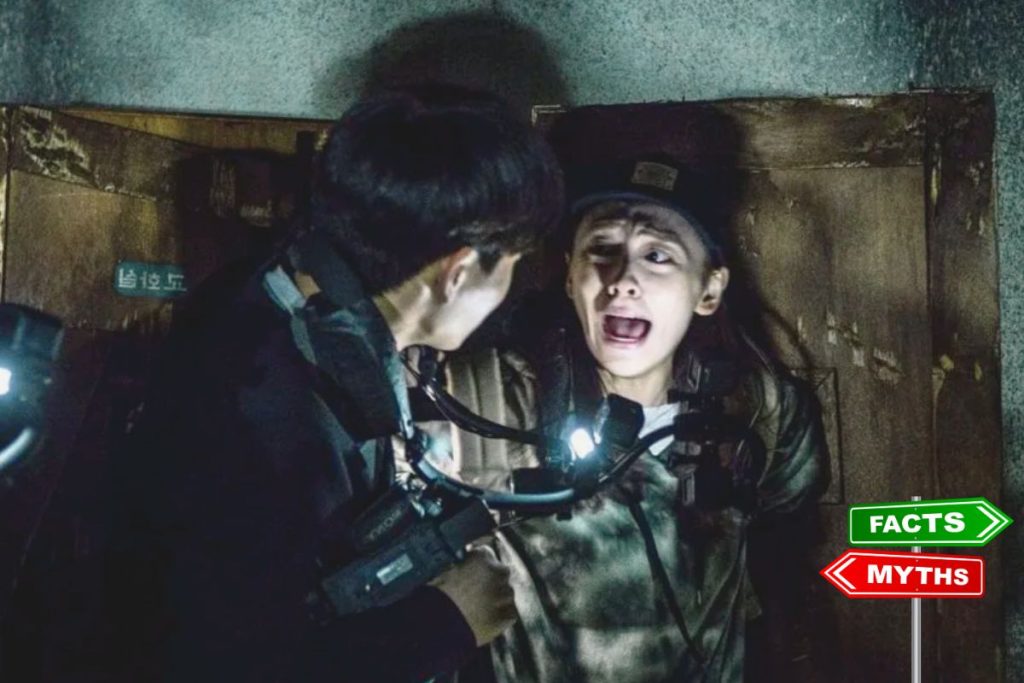
With its found footage style, the movie grips the viewer, making the events feel as though they could have actually happened. But does it? Let’s dive into the mystery surrounding Gonjiam Asylum.
Is Gonjiam Really Scary?
To answer simply, yes, Gonjiam is really scary. The movie uses a combination of jump scares, eerie settings, and psychological tension to create fear. But what makes it even scarier is the fact that the Gonjiam Psychiatric Hospital is a real place in South Korea. Though the movie was filmed in a school in Busan, the hospital layout is a near replica of the actual Gonjiam Asylum.
This abandoned hospital has been the center of many local urban legends, with tales of patients dying mysteriously and the hospital director disappearing without a trace. These stories of hauntings and death have made the hospital a popular spot for ghost hunters and thrill-seekers. This connection between reality and fiction adds an extra layer of fear to the movie.
Is Gonjiam Based Off a True Story?
Is Gonjiam: Haunted Asylum based on a true story? This is a common question, and the answer is a mix of fact and fiction. The Gonjiam Psychiatric Hospital is indeed a real place. It was once a functioning psychiatric facility but was abandoned in the 1990s under mysterious circumstances. Rumors have spread that the hospital closed due to strange deaths and the disappearance of the director, though these stories have never been confirmed.
While the true story behind the hospital is murky, it’s clear that the movie draws inspiration from the eerie atmosphere and creepy legends surrounding the actual asylum. However, the film’s plot, involving a web series crew who explore the haunted hospital for a live broadcast, is purely fictional. In other words, the events of the movie did not happen, but they are based on the disturbing tales of the real asylum.
What Happens at the End of Gonjiam: Haunted Asylum?
If you’ve watched the movie, you might still be wondering, what happens at the end of Gonjiam: Haunted Asylum? The ending leaves viewers with more questions than answers. After the crew members experience terrifying paranormal events, they each meet a grisly fate. The final scene shows the asylum doors closing on their own, leaving the fate of the last surviving crew member uncertain. This open-ended conclusion allows the viewers to interpret what truly happened inside the haunted hospital.
The movie uses this ambiguous ending to leave a lasting impact, as the unanswered questions add to the mystery and fear surrounding the hospital. Did the crew really encounter ghosts? Was it all in their heads? The movie doesn’t provide clear answers, which is part of what makes it so effective in creating fear.
How Many Died in Gonjiam: Haunted Asylum?
In the movie, how many died in Gonjiam: Haunted Asylum? All of the crew members, except one, perish in the asylum. This mirrors the urban legends about the real Gonjiam Asylum, where strange deaths were rumored to have taken place. However, there is no confirmed record of deaths in the actual hospital. The film plays on these rumors, blending fiction with reality to create a truly terrifying experience.
Gonjiam Haunted Asylum True Story Wikipedia
If you search for Gonjiam Haunted Asylum true story on Wikipedia, you’ll find more information about the actual Gonjiam Psychiatric Hospital and the myths that surround it. The hospital’s closure in the 1990s, combined with its abandoned state, led to the spread of ghost stories and rumors about the building being haunted. The movie takes these elements and dramatizes them for a chilling horror experience.
Haunted Asylum Cast Died Rumors
Some viewers have even speculated that the Gonjiam: Haunted Asylum cast died during or after filming. These rumors are completely untrue. The cast, made up of South Korean actors, is alive and well. However, the film’s realistic portrayal and found footage style have led some to believe that the events in the movie were real. This is a testament to the film’s ability to blur the line between fiction and reality.
Gonjiam: Haunted Asylum Full Movie on YouTube and Other Platforms
For those interested in watching the film, you can find Gonjiam: Haunted Asylum full movie on various platforms like YouTube, Bilibili, and Dailymotion. Some viewers may even seek out the Gonjiam: Haunted Asylum English version to understand the terrifying events that unfold in the movie. The film has gained a global following, with discussions on platforms like Reddit where fans debate the movie’s scariest moments and its connection to the real-life asylum.
The Real Gonjiam Asylum and Its Fate
The real Gonjiam Psychiatric Hospital was a place of mystery and intrigue long before the movie was made. Located in South Korea, the hospital was once a place for treating mental illness. However, in the 1990s, it was suddenly abandoned. Rumors of ghost sightings and mysterious deaths began to circulate, and the hospital became a hotspot for urban explorers and ghost hunters.
Despite its eerie reputation, the hospital was demolished in 2018, the same year the movie was released. This left only the chilling stories and memories of what once stood there. Today, the real Gonjiam Asylum exists only in legend, but its terrifying presence lives on through the movie.
So, is Gonjiam: Haunted Asylum a true story? The answer is complicated. While the hospital itself is real and the stories surrounding it are part of local folklore, the events depicted in the film are fictional. The movie cleverly uses real-life inspiration to create a terrifying horror experience that has left a lasting impression on viewers around the world.
Whether you believe in the paranormal or not, there’s no denying that the Gonjiam Psychiatric Hospital has a haunting reputation. The movie, while fictional, taps into our fear of the unknown and plays on the real-life mysteries surrounding the hospital. For those brave enough to watch, it delivers a truly scary experience that sticks with you long after the credits roll.

I am Jeremy Jahns – Your Cinematic Explorer
Immerse in movie reviews, Hollywood insights, and behind-the-scenes stories.